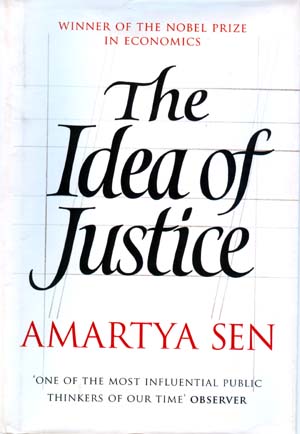Dec 21, 2025
Dec 21, 2025
 Nobel laureate Amartya Sen explores the concept of justice in his new book and comes up with an alternative to the prevailing model, urging the reader to look at today's system -- both judicial and social -- with a critical eye.
Nobel laureate Amartya Sen explores the concept of justice in his new book and comes up with an alternative to the prevailing model, urging the reader to look at today's system -- both judicial and social -- with a critical eye.
Sen's vision of justice and a perfect social order is non-parochial, inclusive and humane. It is entrenched in reason and helps remove inequities. His idea of justice is free of the tyranny of majoritarian will and one that touches lives that people actually live. In the process, it takes global concerns into account.
The economist-philosopher outlines a model that is compassionate. He uses history to drive home the need for mercy. "Twenty-five hundred years ago, when young Gautama, later known as the Buddha, left his princely home in the foothills of Himalayas in search of enlightenment, he was moved specifically by the sight of mortality, morbidity and disability around him, and it agitated him greatly."
Sen says it is easy to understand the sources of Gautama Buddha's agony and "appreciate the centrality of the human lives in reasoned assessments of the world we live in". This, he says, is a central feature of the traditional Indian perspective of 'nyaya' (justice) in contrast to 'niti' (rules). The Nobel laureate's model of justice draws from nyaya.
He quotes from Thomas Hobbes' "Leviathan" to show where the search for an alternative idea of justice should begin. Hobbes wrote that the lives of people are "nasty, brutish and short".
"That was a good starting point for a theory of justice in 1651 and I am afraid that it is still a good starting point for a theory of justice today," writes Sen, who teaches in Harvard University.
The idea is to make people's lives livable and pleasant through a just social set-up, he indicates.
In his hallmark lucid style, Sen uses examples from everyday life to substantiate his arguments for a new system of justice.
Quoting from Charles Dickens' "Great Expectations", he writes: "In this little world in which children have their existence there is nothing so finely perceived and finely felt as injustice."
The strong perception of this injustice applies to the adult as well, he says.
"But what moves us, reasonably enough, is not the realization that the world falls short of being completely just, which few of us expect, but that there are clearly remediable injustices around us which we want to eliminate."
Sen argues that the mainstream system of justice, despite several achievements, has taken us in the wrong direction.
The big difference between Sen and most other theorists of justice is that they use one strand of "enlightenment thinking", while he uses another.
Most theorists swear by the "social contract theory" advocated by thinkers like Thomas Hobbes, John Locke, Jean Jacques Rousseau and John Rawls. Social contract, according to Rousseau, is a societal set-up that is controlled by the "general will" of the people.
Sen's analysis of justice, on the other hand, advances the other theory of "reducing injustice in this world", forwarded by thinkers like Karl Marx, John Stuart Mill and Jeremy Bentham.
Sen argues that the "ability of reasoning" plays an important role in making societies less unjust.
He says reasoning about justice throws up choices between alternative assessments of what is reasonable. Far from rejecting such pluralities or trying to reduce them beyond the limits of reasoning, we should use them to construct a theory that can absorb divergent views.
Sen illustrates the divergent views of justice with the example of three children and a flute.
Anna, Bob and Carla fight over a flute. Anna claims that she should get the flute that is lying on the ground because she knows how to play it, Bob says he should get it because he is poor and has no toys of his own, and Carla says she should get the flute because she made it. Theorists of diverging schools of justice would have different views, Sen writes.
The economic egalitarian -- who is committed to reducing social gaps -- might feel that Bob should get the flute because he is poor; the libertarian would say that Carla should get the flute because she has made it; while the utilitarian hedonist may feel that Anne's pleasure would be greatest because she can play the flute.
Sen feels one cannot brush aside these divergent foundations of thought. "I want to draw attention to the fairly obvious fact that the differences between the three children's justificatory arguments do not represent divergences about what constitutes individual advantage, but about the principles that should govern allocation of resources in general. They are about how social arrangements should be made and what social institutions must be chosen, and through that, what social realizations must come about."
It is not that the needs of the three children differ, but the three arguments on why they need the flute point to a "different type of impartial and non-arbitrary reason". They could be used to address the disparities for an accomplishment-based understanding of justice, says Sen.
The book is divided into four segments - The Demands of Justice, Forms of Reasoning, Materials of Justice and Public Reasoning and Democracy.
The breadth of Sen's vision and intellectual acuity make the book a must-read for every thinking person.
06-Aug-2009
More by : Madhusree Chatterjee